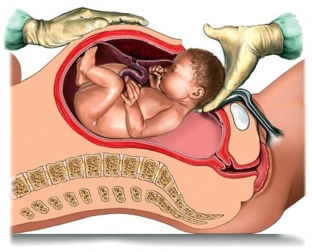Today, caesarean section is a common surgical intervention for everyone. Many women undergo this operation for the most favorable delivery. Caesarean section allows you to avoid many unpleasant consequences in the case when childbirth through the natural birth canal can be difficult for one reason or another. Almost every operating obstetrician-gynecologist has encountered in his practice with a caesarean section. Estet-portal.com talks about the basics of this surgery, which are very important to remember.
Important rules for performing a caesarean section
A caesarean section is an obstetric surgery during which the fetus is removed through an incision in the anterior abdominal wall and uterus. A caesarean section is performed in cases where the birth of a child in a natural way is impossible or fraught with dangerous complications for both the mother and the fetus. This operation is performed in an urgent or planned manner, but it is the planned intervention that improves the outcome for the mother and child. Every obstetrician-gynecologist should be aware of the indications, conditions and possible complications of a caesarean section in order to perform this operation with the best results.
Caesarean section:
- indications on the part of the mother and fetus for a caesarean section;
- Conditions for performing a caesarean section;
- complications after caesarean section and how to avoid them.
Maternal and fetal indications for caesarean section
All indications for caesarean section can be divided into maternal and fetal indications. The main indications on the part of the mother are as follows:
- narrow pelvis, which makes childbirth through the birth canal impossible;
- previa and placental abruption;
- imminent or incipient uterine rupture;
- scars on the uterus or scarring of the cervix;
- oncopathology of the genital organs;
- extragenital pathology;
- Maternal HIV infection.
Main fetal indications:
- fetal hypoxia;
- breech presentation with large fetal weight;
- prolapsed cord loops;
- incorrect fetal positions;
- multiple pregnancy.
Conditions for a caesarean section
There are clear conditions for performing a caesarean section, following which guarantees the most favorable outcome of the operation:
- caesarean section can only be performed if the fetus is alive;
- the fetal bladder must be intact, or the anhydrous period must last up to 12 hours;
- caesarean section should not be performed if the mother is febrile;
- before the operation, it is imperative to obtain consent to the operation from the pregnant woman or her relatives;
- caesarean section is performed under endotracheal anesthesia or epidural anesthesia;
- An appropriately qualified neonatologist and anesthetist must be present in the operating room.

Complications after caesarean section and how to avoid them
Complications after caesarean section are extremely rare, but they should be remembered and prevented in a timely manner. Complications associated with trauma to the bladder, intestines or other structures during surgery require repeated surgical intervention. The most common complication of caesarean section is bleeding. With atony of the uterus, a hysterectomy should be performed, with continued bleeding - ligation of the main vessels of the uterus. A dangerous complication of caesarean section is purulent-septic diseases, such as endometritis, thrombophlebitis, suppuration of the postoperative wound, peritonitis and sepsis. To prevent complications of this kind, all women undergoing caesarean section are prescribed antibiotics.






Add a comment